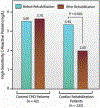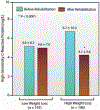Physical activity, cardiorespiratory fitness, and exercise training in primary and secondary coronary prevention
- PMID: 23328449
- PMCID: PMC7027930
- DOI: 10.1253/circj.cj-13-0007
Physical activity, cardiorespiratory fitness, and exercise training in primary and secondary coronary prevention
Abstract
Substantial data have established that higher levels of physical activity (PA), participating in exercise training (ET), and higher overall cardiorespiratory fitness (CRF) provide considerable protection in the primary and secondary prevention of coronary heart disease (CHD). This review surveys data from epidemiological and prospective ET studies supporting the favorable impact of PA, ET, and CRF in primary CHD prevention. Clearly, cardiac rehabilitation and ET (CRET) programs have been underutilized for patients with CHD, particularly considering the effect of CRET on CHD risk factors, including CRF, obesity indices, fat distribution, plasma lipids, inflammation, and psychological distress, as well as overall morbidity and mortality. These data strongly support the routine referral of patients with CHD to CRET programs and that patients should be vigorously encouraged to attend CRET following major CHD events.
Figures




References
-
- Garber CE, Blissmer B, Deschenes MR, Franklin BA, Lamonte MJ, Lee IM, et al. Quantity and quality of exercise for developing and maintaining cardiorespiratory, musculoskeletal, and neuromotor fitness in apparently healthy adults: Guidance for prescribing exercise. Med Sci Sports Exerc 2011; 43: 1334–1359. - PubMed
-
- U.S. Department of Health and Human Services. 2008 physical activity guidelines for Americans. The Department, 2008.
-
- Hu G, Barengo NC, Tuomilehto J, Lakka TA, Nissinen A, Jousilahti P. Relationship of physical activity and body mass index to the risk of hypertension: A prospective study in Finland. Hypertension 2004; 43: 25–30. - PubMed
-
- Paffenbarger RS, Wing AL, Hyde RT, Jung DL. Physical activity and incidence of hypertension in college alumni. Am J Epidemiol 1983;117:245–257. - PubMed
Publication types
MeSH terms
Grants and funding
LinkOut - more resources
Full Text Sources
Other Literature Sources
Medical

